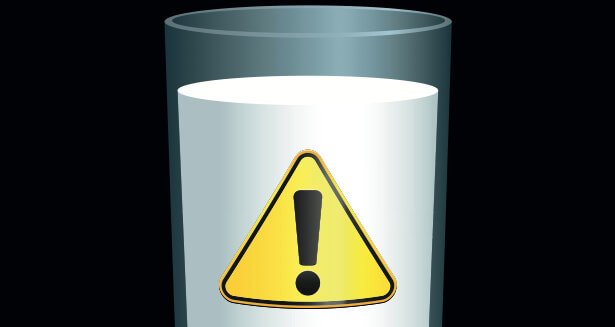
Today, Americans consume an enormous amount of dairy. The intake of the average American is estimated to be over 600 pounds of dairy products per year.[1]
Dairy foods (including cow’s milk) have not been part of the diet of adults for the vast majority of human evolution.[2] We’ve only been consuming these foods for about 7,500 years,[3] compared to the roughly 200,000 years humans have been around (with our basic biochemical functionality evolving still a few million years before that).[4]
Intensive and successful marketing by the dairy industry (including slogans like “Milk – It Does a Body Good” and “Got Milk”) have reinforced a broadly ingrained belief that dairy is good for our health. But is it, really?
Dairy has come under fire and scrutiny from nutritional experts, scientists and physicians for its associations with a number of serious health issues.
1. Even Organic Milk Usually Contains Hormones
Dairy is a significant source of female hormone exposure.[5] Commercial cow’s milk contains large amounts of estrogen and progesterone, which is a serious concern. This is further exacerbated by modern dairy cows being genetically altered to continuously produce milk – even throughout their repeated pregnancies.[5] [6]
Even milk products labeled “organic” or “no hormones added” usually contain high levels of these problematic hormones, which are naturally produced by cows (even if those cows have not been given any additional hormones for purposes of the product label).
- In both adults and children, milk consumption has resulted in markedly increased levels of estradiol and progesterone in blood and urine,[6] and dairy consumption in general has been associated with increased levels of circulating estradiol.[7]
- The data show that men who drink milk will absorb the estrogens in the milk, which has been found to result in significantly decreased testosterone production/levels.[6]
- Pediatricians have expressed concern regarding childhood exposure to the exogenous estrogens in commercial milk, given studies showing that early sexual maturation in prepubescent children can be caused by the “ordinary intake of cow milk.”[6]
- A broad array of multi-centered, peer-reviewed studies has shown that dairy consumption is one of the most concerning and consistent risk factors for hormone-dependent malignant diseases, including ovarian, uterine, breast, testicular and prostate cancers.[5-15]
Also, while there is a culturally popular idea that soy foods may cause feminizing effects, several studies have found that isoflavones (the plant-derived compounds in soybeans with estrogenic activity) do not exert feminizing effects on men, even at high consumption levels.[16] Other studies have found that soy food consumption is even protective against breast cancer.[17] [18] I think we should be far more concerned about the high levels of real female sex hormones found in dairy, the consumption of which results in measurably higher circulating levels of these problematic hormones.[5]
2. Casein From Dairy = Increased Risk of Cancer Development
Casein is the main protein in dairy, and studies have shown that it facilitates the growth and development of cancer. In fact, some studies even found that cancer development could be controlled more by casein levels in diet than by exposure to the underlying carcinogen.[19]
Insulin-like growth factor-1 (or IGF-1), a hormone that promotes cell growth and division in both normal and cancer cells, is thought to be one of the mechanisms responsible for this association. IGF-1 appears to be nutritionally regulated, and animal protein consumption (including casein from dairy foods) leads to higher circulating levels of this cancer-promoting hormone. For this reason, consuming casein from dairy (as well as animal protein in general) is associated with increased risk of cancer development and proliferation.[19-25]
3. Higher Risk of Type 1 Diabetes and Multiple Sclerosis
Our immune system normally protects us from microbes and other harmful substances. But if it loses its ability to recognize and distinguish harmful substances from normal tissues and cells, it can instead mount attacks against our own bodies.
These “auto-attacks” can be triggered by exposure to foreign peptides (including animal protein fragments found in dairy), which have similarities to components in the human body. This can result in our immune system becoming “confused” and misidentifying tissues in our body as “foreign” and thus in need of being attacked and destroyed.
Dairy is associated with increased risk of several immune-related disorders (from allergic conditions to autoimmune diseases), many being life-changing and difficult to treat. The associations with type 1 diabetes and multiple sclerosis are particularly concerning:
- Type 1 Diabetes. In type 1 diabetes (also called juvenile diabetes or insulin-dependent diabetes mellitus (IDDM)), the immune system attacks the pancreas, resulting in the body no longer being able to produce insulin to regulate glucose. Multiple large-scale studies have identified an association between cow’s milk consumption and increased prevalence of type 1 diabetes.[26-30] One such study found that “cows’ milk may contain a triggering factor for the development of IDDM,”[26] and another found that “[e]arly cow’s milk exposure may be an important determinant of subsequent type 1 diabetes and may increase the risk approximately 1.5 times.”[27]
- Multiple Sclerosis. In multiple sclerosis (MS), the immune system attacks the insulating sheath of our own nervous system, resulting in a variety of difficult-to-treat and unpredictable neurologic problems. As with type 1 diabetes, numerous studies have reported that cow’s milk consumption may be a significant risk factor for developing MS.[31] [32] [33]
4. Even Pasteurized Milk Contains Microorganisms
Milk and other dairy products are important vehicles for foodborne pathogens due to a variety of microorganisms they harbor.[34] Even with modern sanitation requirements, including pasteurization and curing, outbreaks still occur, resulting in severe and sometimes even fatal outcomes.
Salmonella, Listeria, and E. coli are some of the more common foodborne outbreaks associated with dairy.[35] Just last year, for example, three people tragically died from Listeria infections linked to Blue Bell Ice Cream (prompting a large-scale recall by Blue Bell Creameries).[36] [37]
Not even our food regulatory agencies expect milk will be sterile after pasteurization; the heating process is done merely to reduce (not eliminate) the amount of microorganisms.
5. Dairy Products Accumulate Pesticides in High Concentrations
Exposure to organochlorine pesticides (OCP) is another problem associated with dairy. While pesticide contamination affects water and agricultural lands generally, dairy products have a greater capacity to accumulate these pesticides in higher concentrations, due in part to their high fat content.[38] [39]
Even pesticides that have long been banned still show up when dairy products are tested. Some OCPs (like DDT, which was widely used in the past and now banned as a human carcinogen) still persist in the environment and can more easily accumulate in animal food products, including dairy.
In India, milk and other dairy products (like cheese and butter) have been reported as the major sources of dietary DDT and hexachlorocyclohexane (HCH),[40] and routine monitoring detected that milk from dairy farms in Italy’s Sacco River Valley had levels of ß-HCH twenty times higher than the legal limit.[41]
6. Increased Exposure to Antibiotic Residue
The largest use of antibiotics worldwide is for livestock.[42] Much of that use is for non-therapeutic purposes, such as infection prevention and to promote feed efficiency and animal growth.[43]
Apart from the dire warnings from scientists that agricultural overuse is leading to antibiotic resistance,[44] [45] another problem is that antibiotic residues persist in milk and other dairy products despite protocols aimed to minimize this.
It is difficult to prevent and control these antibiotic residues because milk from individual cows and farms is usually pooled together, and the administration, handling and record-keeping of animal drug use can vary significantly from one dairy operation to another.[46]
The resulting low-dose antibiotic exposure can lead to a variety of problems, from developing antibiotic resistance to allergic reactions to experiencing side-effects of the medication to which a person is exposed.
7. Dairy Can Lead to Bone Problems Too
This may come as a surprise to many, but dairy does not appear to be good for bone health, either.
Not only has the body of scientific evidence been found inadequate to support the idea that dairy consumption promotes bone health,[47] but numerous large-scale studies have found that consuming dairy may actually be detrimental to bone health.[48-51] In fact, there is substantial data linking higher milk intake with significantly increased risk of bone fractures.[48] [49] [50] [51]
There are several mechanisms thought to be responsible for the pathophysiology. One is dairy’s high calcium content, which can cause vitamin D dysregulation and therefore disrupt bone homeostasis. Another is that the high animal protein content of dairy can induce acidosis from its high proportion of sulfur-containing amino acids, which in turn leads to the body compensating by leaching calcium from the bones to help neutralize the increased acidity. Over time, all of this can have a detrimental effect on bone health.[49-60]
While several other factors, such as physical activity, can affect bone health, it’s significant to note that the U.S. has one of the highest rates of hip fractures in the world, despite our high milk intake. By contrast, in countries like Japan and Peru, where average daily calcium intake is as low as 300 milligrams per day (less than a third of the U.S. daily recommendation for adults), the incidence of bone fractures is actually quite low.[48] [49] [61]
Fortunately, calcium is abundant in plant foods, including leafy green vegetables, legumes and seeds, often with higher absorption rates than the calcium in dairy—and of course without all of dairy’s associated health problems.
CONCLUSIONS
Each mammalian species produces milk for its own babies, and the content of proteins, fats, carbohydrates and minerals is specific to provide optimum nutrition for a baby of that particular species. The milk from an elephant, tiger, sea lion and cow are each different from one another, and they are all different from human milk.
When we think about it, the health problems associated with consuming the milk and dairy products of other species should not come as any surprise. No other species consumes milk regularly past the weaning period and certainly not from another species—and, as mentioned above, we humans have also not being doing so for the vast majority of our own evolutionary history.
Fortunately, with plant milks, such as soy, almond and rice now available, as well as delicious plant-based versions of other dairy products, it’s never been easier or more convenient to completely avoid dairy.
Source: https://www.forksoverknives.com/7-ways-milk-and-dairy-products-are-making-you-sick/#gs.4O3eNuY
Disclaimer: We at Prepare for Change (PFC) bring you information that is not offered by the mainstream news, and therefore may seem controversial. The opinions, views, statements, and/or information we present are not necessarily promoted, endorsed, espoused, or agreed to by Prepare for Change, its leadership Council, members, those who work with PFC, or those who read its content. However, they are hopefully provocative. Please use discernment! Use logical thinking, your own intuition and your own connection with Source, Spirit and Natural Laws to help you determine what is true and what is not. By sharing information and seeding dialogue, it is our goal to raise consciousness and awareness of higher truths to free us from enslavement of the matrix in this material realm.
 EN
EN FR
FR


























Sorry, but uninformed authors disguised as expert researchers should be ignored or take their content as a dose of humor. God and many Masters have spoken on this! No, they never went silent! Who told you they did? We do still have such a thing as “inspiration” and guidance! Just don’t tell that to your local preacher or priest! As the saying goes, if you think meat is bad it will be. Milk, dairy? Same thing! Just enjoy it, be thankful for it and move on about your day knowing everything you need is given! Unless you pinch it off with negative feeling and beliefs, worries and fear. Why are there people who smoked all their life and into their 80’s and 90’s they went? They had no time for worrying or being fearful! Read Yogananda’s book and the story of his Guru Trailanga who drank down a pitcher of calcium-lime concoction and watched as the scoffer who gave it to him fell to the ground dying only to be saved and healed by Trailanga.
This article is only true (perhaps) of pasteurized, homogenized mass produced milk. However, raw unadulterated goat milk, from an animal fed a healthy, organic diet and even cows milk to a degree, are very healing, especially when drunk within 4 hours of the animal being milked.
Sólo puedo lamentaron profundamente por los millones de vacas sacrificadas tan injustamente por la técnica Draco Lagarto, para enfermar a los humanos.
Fin de la IGNORANCIA yaaaa!!
THANK YOU FOR THIS VERY INFORMATIVE ARTICLE.
AS FAR AS I’M CONCERNED I’VE NO LONGER
EATING A DAIRY FOOD. I STOPPED DRINKING MILK
MORE THAN 15 YEAR AGO.
I’M DRINKING ALMOND MILK AND GETTING VEGAN
MAGNESIUM SUPPLEMENT DAILY.
I’VE NOTICED THAT MY TEETH ARE MORE STONGER
THAN EVER. MAGNESIUM SUPPLEMENT IS BETTER
THAN CALCIUM SUPPLEMENT FOR THE BONE HEALTH
LOVE&LIGHT TO ALL